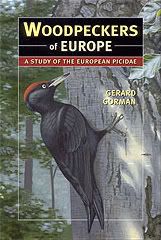Friday, 28 September 2007
Woodpecker moult
The moult regime of the true woodpeckers is rather unusual and this is related to the lifestyle of the family, in particular to foraging habits and to the breeding cycle. A typical European woodpecker (all except Wryneck) has ten primaries, eleven secondaries, and twelve tail feathers. Primaries 6, 7 and 8 are the longest and P10 is reduced in size in adults but is longer and broader in juveniles. Most adult woodpeckers begin a complete post-breeding moult in late spring or early summer soon after breeding has finished and this lasts into autumn. Primaries are moulted sequentially (ascendant) from P1 and the secondaries from two centres (ascendantly from S1, ascendantly and descendantly from S8). The outermost rectrices are also much shorter than the other tail feathers, the central two being the longest. These two feathers are so important as props when climbing and clinging to vertical surfaces, so they are replaced last, after the other tail feathers. Counting the central two as R1 moult starts ascendantly in pairs from R2 to R6 with R1 last. There is no pre-breeding moult for the true woodpeckers, though Wryneck has a partial pre-breeding moult. Wrynecks moult their tail feathers in reversed sequence.
Subscribe to:
Post Comments (Atom)





No comments:
Post a Comment